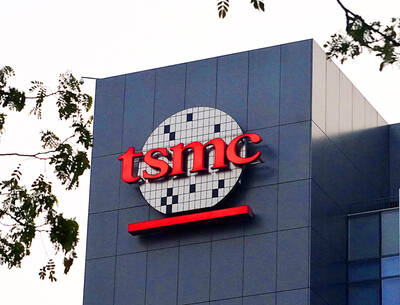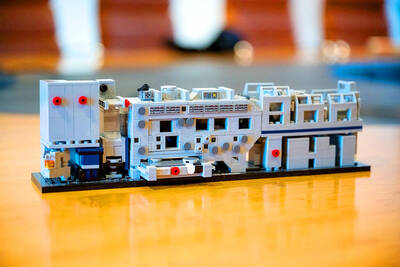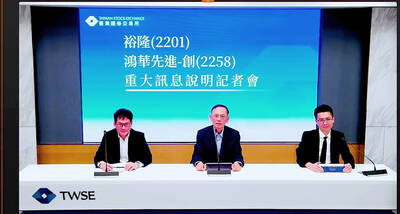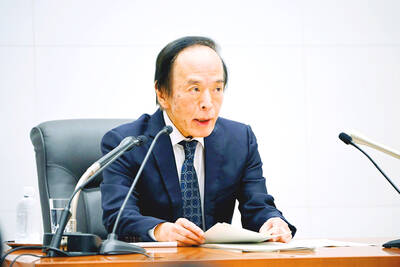Domestic banks saw first-quarter net profits from their Hong Kong branches shrink 25 percent on an annual basis to NT$4.8 billion (US$159.83 million), the first drop in the past four years, due to higher loan-loss provisions and lower interest income, Financial Supervisory Commission data showed.
Local banks’ branches in the financial hub saw interest income fall after the Hong Kong Monetary Authority in March lowered its base interest rate to 0.86 percent, compared with 2.75 percent a year earlier, the data showed.
Those branches set more loan-loss provisions out of concerns that some loans might turn sour due to the COVID-19 pandemic disrupting production and weakening market demand, Banking Bureau Chief Secretary Phil Tong (童政彰) said.
The branches saw wider valuation losses on their financial investments as the Hang Seng Index slid to a three-year low, a decline similar to those of major equity markets in Taiwan and the US, Tong said.
The Hang Seng yesterday extended the downtrend by closing down 0.74 percent to 22,961.47 points, as the passage of Hong Kong national security legislation spurred speculation about capital flight and prompted concerns that the law would jeopardize the territory’s status as an international financial center.
Hong Kong has been an important overseas market for local banks due to the territory’s advantages, including the lack of a limit on fund flows, clear regulations, a friendly tax system and low tax rates, Tong said.
Nineteen of the nation’s 35 banks have set up branches in Hong Kong, with the banks’ net profits in the territory accounting for half of their overseas net profits, Tong said.
“Local banks should keep close watch on the changes in Hong Kong’s political and economic situation, regulations and market sentiment. They should consider these factors when resetting their risk appetite,” Tong said.
There has not been a significant capital outflow from the territory, but in the first three months of this year, the banks’ combined deposits have dropped NT$29.5 billion to NT$1.13 trillion, Tong said.
By comparison, the banks’ lending rose NT$30.2 billion quarterly to NT$638 billion, Tong said, adding that the gain might be attributable to new loans granted to firms affected by the pandemic.

Taiwan’s long-term economic competitiveness will hinge not only on national champions like Taiwan Semiconductor Manufacturing Co. (TSMC, 台積電) but also on the widespread adoption of artificial intelligence (AI) and other emerging technologies, a US-based scholar has said. At a lecture in Taipei on Tuesday, Jeffrey Ding, assistant professor of political science at the George Washington University and author of "Technology and the Rise of Great Powers," argued that historical experience shows that general-purpose technologies (GPTs) — such as electricity, computers and now AI — shape long-term economic advantages through their diffusion across the broader economy. "What really matters is not who pioneers

In a high-security Shenzhen laboratory, Chinese scientists have built what Washington has spent years trying to prevent: a prototype of a machine capable of producing the cutting-edge semiconductor chips that power artificial intelligence (AI), smartphones and weapons central to Western military dominance, Reuters has learned. Completed early this year and undergoing testing, the prototype fills nearly an entire factory floor. It was built by a team of former engineers from Dutch semiconductor giant ASML who reverse-engineered the company’s extreme ultraviolet lithography (EUV) machines, according to two people with knowledge of the project. EUV machines sit at the heart of a technological Cold

TAIWAN VALUE CHAIN: Foxtron is to fully own Luxgen following the transaction and it plans to launch a new electric model, the Foxtron Bria, in Taiwan next year Yulon Motor Co (裕隆汽車) yesterday said that its board of directors approved the disposal of its electric vehicle (EV) unit, Luxgen Motor Co (納智捷汽車), to Foxtron Vehicle Technologies Co (鴻華先進) for NT$787.6 million (US$24.98 million). Foxtron, a half-half joint venture between Yulon affiliate Hua-Chuang Automobile Information Technical Center Co (華創車電) and Hon Hai Precision Industry Co (鴻海精密), expects to wrap up the deal in the first quarter of next year. Foxtron would fully own Luxgen following the transaction, including five car distributing companies, outlets and all employees. The deal is subject to the approval of the Fair Trade Commission, Foxtron said. “Foxtron will be

INFLATION CONSIDERATION: The BOJ governor said that it would ‘keep making appropriate decisions’ and would adjust depending on the economy and prices The Bank of Japan (BOJ) yesterday raised its benchmark interest rate to the highest in 30 years and said more increases are in the pipeline if conditions allow, in a sign of growing conviction that it can attain the stable inflation target it has pursued for more than a decade. Bank of Japan Governor Kazuo Ueda’s policy board increased the rate by 0.2 percentage points to 0.75 percent, in a unanimous decision, the bank said in a statement. The central bank cited the rising likelihood of its economic outlook being realized. The rate change was expected by all 50 economists surveyed by Bloomberg. The